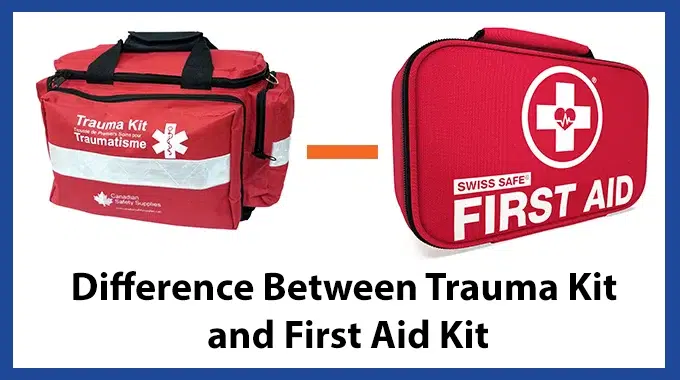Last Updated on April 13, 2023
A trauma kit is designed for life-threatening situations, such as car accidents, gunshot wounds, and severe injuries, while first aid kits are intended for minor injuries, such as cuts, scrapes, and burns. When stocking an adventure medical kit, it is essential to know the difference between a trauma kit and a first aid kit.
Trauma kits contain tourniquets, emergency dressings, and chest seals, which do not usually appear in first aid kits. A first aid kit contains bandages, gauze, and antiseptic wipes. While both types of kits are essential to have on hand, it is crucial to know when to use each.
Using the wrong type of kit could mean life or death, depending on the situation. Please continue reading to understand better how a trauma kit differs from a first aid kit and what to stock in your RV and home in an emergency.
What is the Difference Between Trauma Kit and First Aid Kit?
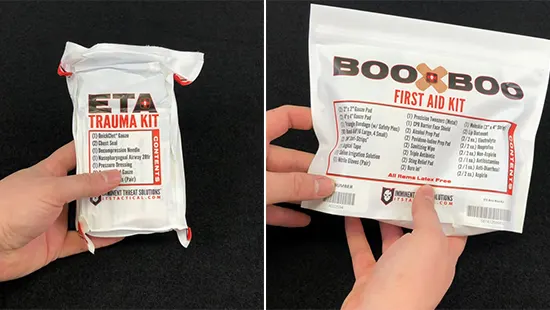
When it comes to medical care, it’s essential to be prepared for anything. Many people choose to keep a first aid kit on hand. But what about situations where more than just a bandage is needed? That’s where a trauma kit comes in.
Although there are many similarities between trauma kits and first aid kits, there are also some critical differences:
The Intentions
A first aid kit is a collection of supplies and tools used to provide medical treatment. A trauma kit is a specialized first aid kit for traumatic events like car accidents, shootings, and natural disasters.
While both kits can treat various medical conditions, a trauma kit contains additional supplies and equipment to stop bleeding, stabilize fractures, and provide airway support. Also, a tactical trauma kit often contains drugs useful to manage pain and prevent infection.
Skill Level
A first aid kit is usually carried by someone with training in first aid, such as a doctor, nurse, or emergency medical technician (EMT). A first aid kit may also be kept where it is easily accessible in an emergency, such as in a home, office, or car.
A trauma kit is usually only used by trained medical professionals, such as EMTs or surgeons. It is a type of first aid kit designed for use in situations with a severe injury or death risk. A trauma kit may contain sterile dressings, gloves, and a CPR mask. It may also include more specialized equipment, such as a tourniquet or chest seals.
Instruments
Trauma kits typically contain dressings, bandages, splints, tourniquets, and trauma pads. They may also include medications, such as painkillers and antibiotics. In some cases, trauma kits may also include extra supplies such as an oxygen tank, chest seal, and airways.
First aid kits, on the other hand, are designed to treat minor injuries and illnesses. Common items in a first aid kit include bandages, antiseptic wipes, gauze pads, and over-the-counter medications. Some first aid kits also contain supplies for more serious injuries, such as splints and CPR masks.
What are the 4 Goals of First Aid?
A first aid provider’s goal is to preserve life. This means ensuring the patient remains alive and does not succumb to their injuries or illness. Sometimes, this may mean performing CPR or using a defibrillator to jump-start the heart. In other cases, it may involve keeping the patient comfortable and ensuring they do not experience further harm.
The second goal of first aid is to alleviate suffering. This means doing everything possible to ease the pain and discomfort that the patient is experiencing. This may involve providing medication, applying cold compresses, or offering reassurance and support.
Thirdly, first aid aims to prevent further illness or injury. This means taking steps to protect the patient from any additional harm. For example, first aid providers will stabilize a patient’s spine if they have suffered a spinal injury. Similarly, first aid providers will prevent further blood loss if a patient’s bleeding is heavy.
Finally, the fourth goal of first aid is to promote recovery. Doing so can help the patient heal from their injuries or illness and return to their average level of function. Providing physical therapy, allowing daily patient activities, or offering emotional support.
By working towards these four goals, first aid providers can make a real difference in the lives of those they treat.
How Do You Make a DIY First Aid Kit?
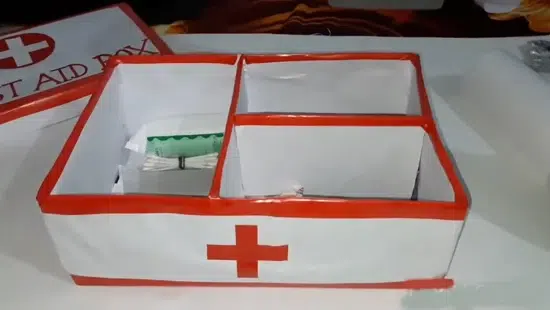
No one likes getting hurt, but it’s inevitable. Whether you’re a klutz like me or have kids, accidents happen. That’s why it’s crucial to be prepared with a first aid kit. You can buy a pre-made kit at any store, but they can be expensive and often have items you’ll never use.
A better option is to make your own DIY first aid kit. Below is a list of items you should include in a DIY first aid kit:
First Aid Pouch
Start with a small pouch or container to store everything in. The pouch should be easily accessible in case of an emergency. This pouch should be sturdy enough to withstand being thrown in a bag or purse and have a water-resistant lining so that you can quickly grab it and go.
Wound Cleaning Agent
A minor cut can quickly become a big problem if infected. So, having a wound-cleaning agent in your DIY first aid kit is significant. Antiseptic wipes are ideal for mild injuries. If you’re keeping a larger first aid kit, you could also include small hydrogen peroxide or Hibiclens bottle.
Isopropyl alcohol or alcohol wipes can also be used to clean wounds, but they may sting. If you’re caring for children, antiseptic wipes or hydrogen peroxide is best. You’ll be prepared to cleanse wounds and prevent infection by including a disinfectant in your first aid kit.
Nitrile Exam Gloves
Nitrile exam gloves are one of the most important items that you can have in your DIY first aid kit. Providers of first aid use gloves to avoid coming into contact with the blood or other body fluids of others.
Blood-borne pathogens are a genuine and severe risk. You may not be concerned about that when it’s your kid, but if you’re helping someone else, make sure your good deed doesn’t have an adverse effect on you.
The use of nitrile exam gloves prevents the spread of infections as well as protects you. First aid can make someone’s injury worse if you infect them with something you have on your hands while providing first aid. These gloves provide a barrier that helps to keep both you and the person you’re helping safe from disease.
Adhesive Bandages
Bandages are an obvious choice for a first aid kit, and you should stock a variety of sizes and types, including knuckle and fingertip bandages. Fabric bandages hold better than paper ones, and waterproof bandages are also a good option. In particular, if you have children, this is a logical choice.
Don’t forget to include items of different sizes and shapes in your first-aid kit. Band-Aids are the most common type of adhesive bandage, but you should also include butterfly closures and sticky tape. Butterfly closures close up deeper cuts, while adhesive tape is used to secure gauze pads or other dressings.
Antibiotic Ointment
Antibiotic ointment is a good way to prevent infection in slight cuts and scrapes. This should be in every individual first aid kit as it can help prevent infection in even minor wounds.
The antibiotic may be provided in the form of a packet of antibiotic ointment or in the form of a tube of Neosporin. The prevention of infection is of paramount importance, regardless of the method.
Cotton Balls and Swabs
Helpful in cleaning wounds and applying ointments or creams. Cotton balls can also be used as an emergency fire starter (just add some Vaseline). Swabs are handy for applying lotions in hard-to-reach places such as the middle of the back.
Antiseptic Wipes
Antiseptic wipes are useful for cleansing wounds and preventing infection. Be sure to include both alcohol-based and iodine-based antiseptic wipes in your first-aid kit.
Alcohol-based wipes are good for general cleaning, while iodine-based wipes are ideal for more serious wounds. Iodine can help to prevent infection in deep cuts and puncture wounds.
Sterile Gauze Pads
Sterile gauze pads are essential for covering wounds and absorbing blood. Be sure to include a variety of sizes in your first-aid kit. Gauze pads can also be used as makeshift Band-Aids if you’re out of adhesive bandages.
Burn Treatment
Burns can happen anywhere, so it’s important to be prepared. To make a DIY first aid kit for burns, you’ll need burn gel packets and sterile gauze or burn dressings. Stop the burn by cooling it off somehow. Then, wrap the burned area with the gauze or dressing. This will mitigate further damage and speed up the healing process.
OTC (Over-the-counter) Medication
OTC medication is a key component of any first aid kit. Ibuprofen and acetaminophen are great for pain relief and reducing fever. Diphenhydramine can be used in case of mild allergic reactions. Aspirin can be kept on hand in case of a possible heart attack.
Oral glucose and an Epi-Pen may also be included based on your needs. A well-stocked first aid kit will help you be prepared for illnesses and minor injuries.
These are some basics that should be included in every first aid kit. Yet, you may also want to include other items based on your specific needs. For example, if you have allergies, consider carrying an Epi-Pen. If you have diabetes, you may want to include oral glucose.
What is a Trauma First Aid Kit?
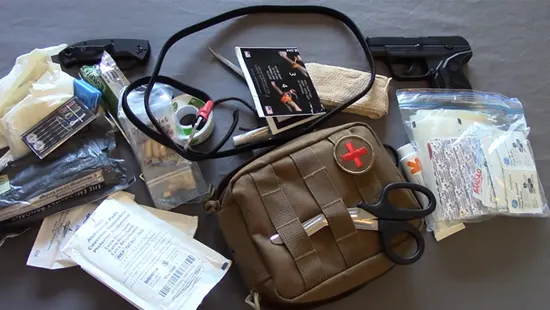
A trauma first aid kit is a set of aid supplies and equipment that can be used to treat major injuries in an emergency situation. The survival kit includes items to stop bleeding, splint broken bones, and treat other traumatic injuries. It also contains supplies for applying other basic first aid measures.
The contents of a trauma first aid kit will vary depending on the climate and terrain where it will be used, but all kits should contain basic items such as bandages, gauze, tape, and scissors. More sophisticated kits may include tourniquets, hemostatic dressings, and chest seals.
Sometimes, a trauma first aid kit may also include medical supplies for treating other injuries, such as burns or eye injuries. Regardless of its contents, a trauma first aid kit is an essential tool for anyone who may find themselves in a situation where they need to provide medical care.
What is the Importance of Preparing a Trauma First Aid Kit?
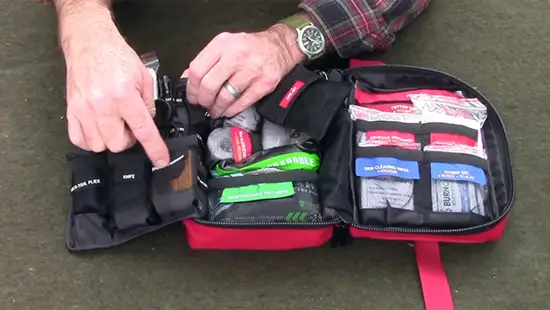
Having a trauma first aid kit on hand cannot be understated. In an emergency, every minute counts, and having a well-stocked emergency kit can make all the difference. Trauma first aid kits provide primary, immediate care for common injuries like cuts, burns, and fractures.
By quickly attending to these injuries, these kits can help to prevent further damage and ensure a speedy recovery. These kits come in a variety of sizes and can be customized to suit the needs of a particular individual or group.
Regardless, all first-aid kits should contain basic supplies, including bandages, dressings, antiseptic wipes, pain relievers, and cold packs.
Also, these kits can help to ease anxiety and provide peace of mind in an otherwise chaotic situation. Having a well-stocked first-aid kit on hand can help reduce an injury’s severity and potentially save lives. For all these reasons, always carrying a trauma first aid kit is essential.
How Do You Properly Stock a Trauma First Aid Kit?
When stocking a trauma first aid kit, it is important to include items addressing the most common causes of death during an emergency: bleeding, airway obstruction, and hypothermia. Here are some specific things to include:
- Bleeding control: gauze pads, roller gauze, trauma dressings, clotting gauze, tourniquet
- Airway management: nasopharyngeal airway, pocket mask with oxygen port, suction device
- Hypothermia prevention: mylar blanket, space blanket, chemical heat packs
Including these essential items ensures that your trauma first aid kit contains everything you need and is ready to use in an emergency.

